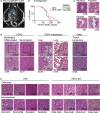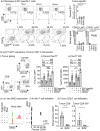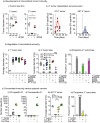Tumor resident memory CD8 T cells and concomitant tumor immunity develop independently of CD4 help
- PMID: 37072485
- PMCID: PMC10113239
- DOI: 10.1038/s41598-023-33508-1
Tumor resident memory CD8 T cells and concomitant tumor immunity develop independently of CD4 help
Abstract
Tissue resident memory (Trm) CD8 T cells infiltrating tumors represent an enriched population of tumor antigen-specific T cells, and their presence is associated with improved outcomes in patients. Using genetically engineered mouse pancreatic tumor models we demonstrate that tumor implantation generates a Trm niche that is dependent on direct antigen presentation by cancer cells. However, we observe that initial CCR7-mediated localization of CD8 T cells to tumor draining lymph nodes is required to subsequently generate CD103+ CD8 T cells in tumors. We observe that the formation of CD103+ CD8 T cells in tumors is dependent on CD40L but independent of CD4 T cells, and using mixed chimeras we show that CD8 T cells can provide their own CD40L to permit CD103+ CD8 T cell differentiation. Finally, we show that CD40L is required to provide systemic protection against secondary tumors. These data suggest that CD103+ CD8 T cell formation in tumors can occur independent of the two-factor authentication provided by CD4 T cells and highlight CD103+ CD8 T cells as a distinct differentiation decision from CD4-dependent central memory.
© 2023. The Author(s).
Conflict of interest statement
MJG receives research funding from Bristol Myers Squibb and VIR Biotechnology. KY receives research funding from Bristol Myers Squibb and consulting fees/stock from Synthis Therapeutics. MRC receives consulting fees from Roche. All other authors have no conflicts to declare. Research funding is not directly related to the topic of this manuscript. Funders had no role in the representation of the data or the preparation of the manuscript.
Figures







Similar articles
-
Functional Heterogeneity of CD4+ Tumor-Infiltrating Lymphocytes With a Resident Memory Phenotype in NSCLC.Front Immunol. 2018 Nov 16;9:2654. doi: 10.3389/fimmu.2018.02654. eCollection 2018. Front Immunol. 2018. PMID: 30505306 Free PMC article.
-
The Emerging Role of CD8+ Tissue Resident Memory T (TRM) Cells in Antitumor Immunity: A Unique Functional Contribution of the CD103 Integrin.Front Immunol. 2018 Aug 15;9:1904. doi: 10.3389/fimmu.2018.01904. eCollection 2018. Front Immunol. 2018. PMID: 30158938 Free PMC article. Review.
-
CD103+CD8+ TRM Cells Accumulate in Tumors of Anti-PD-1-Responder Lung Cancer Patients and Are Tumor-Reactive Lymphocytes Enriched with Tc17.Cell Rep Med. 2020 Oct 20;1(7):100127. doi: 10.1016/j.xcrm.2020.100127. eCollection 2020 Oct 20. Cell Rep Med. 2020. PMID: 33205076 Free PMC article.
-
Intratumoral interleukin-2/agonist CD40 antibody drives CD4+ -independent resolution of treated-tumors and CD4+ -dependent systemic and memory responses.Cancer Immunol Immunother. 2012 Apr;61(4):549-60. doi: 10.1007/s00262-011-1120-5. Epub 2011 Oct 15. Cancer Immunol Immunother. 2012. PMID: 22002241 Free PMC article.
-
Resident memory T cells, critical components in tumor immunology.J Immunother Cancer. 2018 Sep 4;6(1):87. doi: 10.1186/s40425-018-0399-6. J Immunother Cancer. 2018. PMID: 30180905 Free PMC article. Review.
Cited by
-
Enhancing radiotherapy response via intratumoral injection of a TLR9 agonist in autochthonous murine sarcomas.JCI Insight. 2024 Jun 13;9(14):e178767. doi: 10.1172/jci.insight.178767. JCI Insight. 2024. PMID: 39133651 Free PMC article.
-
Fluorescence tracking demonstrates T cell recirculation is transiently impaired by radiation therapy to the tumor.Sci Rep. 2024 May 24;14(1):11909. doi: 10.1038/s41598-024-62871-w. Sci Rep. 2024. PMID: 38789721 Free PMC article.
-
Advancing cancer immunotherapy: from innovative preclinical models to clinical insights.Sci Rep. 2024 Jan 12;14(1):1205. doi: 10.1038/s41598-024-51704-5. Sci Rep. 2024. PMID: 38216668 Free PMC article.
-
Comprehensive analysis of mitochondrial-related gene signature for prognosis, tumor immune microenvironment evaluation, and candidate drug development in colon cancer.Sci Rep. 2025 Feb 20;15(1):6173. doi: 10.1038/s41598-024-85035-2. Sci Rep. 2025. PMID: 39979377 Free PMC article.
-
The potential of DEirlncRNAs: A novel approach to predict glioblastoma prognosis.Heliyon. 2024 Feb 22;10(5):e26654. doi: 10.1016/j.heliyon.2024.e26654. eCollection 2024 Mar 15. Heliyon. 2024. PMID: 38434266 Free PMC article.
References
Publication types
MeSH terms
Substances
Grants and funding
LinkOut - more resources
Full Text Sources
Medical
Molecular Biology Databases
Research Materials

